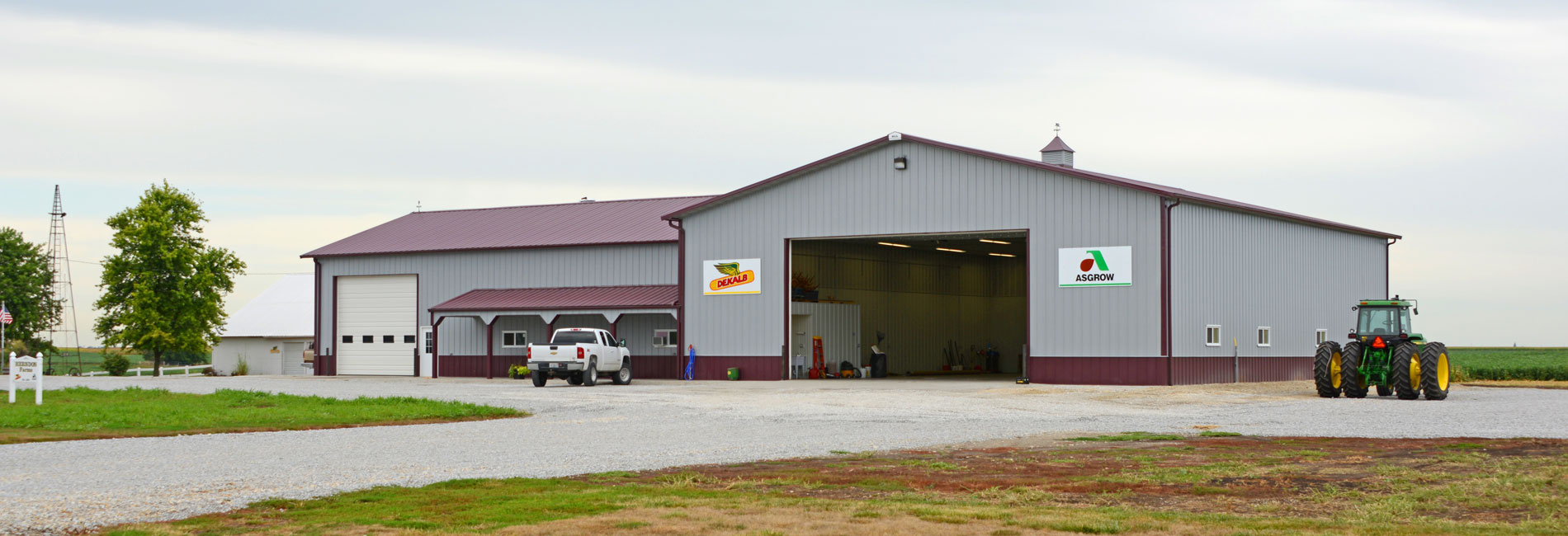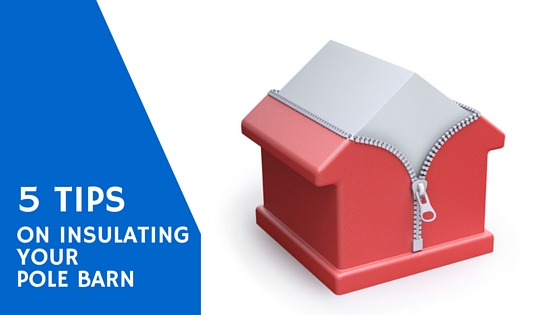
Between fiberglass, cellulose, and foam, there are numerous ways to insulate a post-frame building. But how to insulate a pole barn based on your needs is the key. Here are five tips on how to insulate a pole barn to best fit your needs.
Whether you are building a garage to store your tractor, or constructing a small “man cave” in your backyard, how you prevent unwanted air movement into and out of your building is an important consideration.
After all, the decision will dictate the heating and cooling characteristics, noise levels, and the type of ventilation in your building.
Insulation is important because it separates indoor and outdoor elements. Keeping the heat out when it is hot — and in when it is cold — is what keeps you comfortable in your home, and saves you cash.
Uncontrolled air flow can create moisture and condensation. Over time, it can cause deterioration. It can damage valuables stored inside, too, by causing rust, mold, and mildew.
Before we offer our tips on insulating a pole barn building, here are two key attributes of insulation:
Pole Barn Insulation Thickness
One or two inches
One or two-inch insulation can be placed on the exterior of the building, underneath the steel. It ranges from R-5 to an R-16 value, depending on the type.
R values indicate the insulative properties of the material used. The higher the R value, the higher the insulation capacity.
For instance, R-5 faced fiberglass insulation has a relatively low insulative value and is often used under roofs to avoid condensation on cold days, and to reduce heat on sunny ones.
On the other hand, a two-inch rigid foam insulation rated at R-16 provides 3 times the insulative value under steel.
In addition to providing some heat gain and condensation control, thinner insulation also provides some noise protection from the outside and absorbs noise inside the building.
Six inches
A six-inch fiberglass batt (blankets, sheets or rolls) typically has value of R-19.
While the insulative property is higher and cost is very reasonable, it’s thicker than insulation applied under the steel.
That is why it is typically used with interior framed walls — often called a “flush wall” in a pole barn. While it adds to the price of the building, it also allows for a number of interior finishing options.
Insulation Materials
Fiberglass
This is the industry standard, and the most commonly used material. It’s lightweight, often the lowest cost insulation option and is used in batt or blown form (pieces) into the attic.
Most builders and construction crews can properly put batt fiberglass insulation in place. However, blown fiberglass requires special equipment, protective gear and some training.
Foam
While it does a great job insulating the building, foam is more expensive. In addition to its expense, you may have to hire a person independent from your builder to install it.
Cellulose
This type of blown insulation is typically put in the attic. It is usually made out of renewable materials and has a slightly higher R-value per inch than blown in fiberglass.
How to Insulate a Pole Barn: 5 Tips to Help You Do It Right

1. Determine what your needs are.
The type of insulation you choose depends on your needs.
Will you work in your garage for only a couple of hours at a time in mild weather? Install a one or two-inch insulation under the steel. Are you insulating your attic? Consider high-density blown cellulose.
2. Animal confinement buildings often don’t need wall insulation.
This is because animals themselves, especially horses, generate a lot of heat. We advise you to place insulation under the steel of the roof to reduce condensation during summer.
What’s important to remember for a horse barn or other animal confinement facilities is ventilation. Animals need quality indoor air to remain healthy, so plan your building to include plenty of airflow.
3. Consider DripStop condensation control.
It’s the hottest thing to hit the market in recent years. While it’s not a huge insulator, it does control condensation.
DripStop is best for a warehouse unit, animal confinement or any cold-storage building in which you want to deter moisture.
The material is applied directly to the steel. It is one-third the cost of normal roof insulation.
If you do not plan to spend too much time in the tractor garage, but are looking to prevent condensation from forming or dripping on high-end equipment, DripStop is for you. A farmer storing tractors, for instance, is a great candidate for DripStop.
Using DripStop can save you thousands of dollars. It accomplishes condensation control like insulation does, but without the additional material and labor costs.
4. Use an air/moisture barrier layer.
If you plan to heat or cool your building, use an air barrier, such as Tyvek, on the outside of the insulation, and poly on the inside, to minimize unwanted airflow.
Make sure your builder knows how to properly seal the Tyvek around doors and windows. Proper sealing will keep both air and water from getting into your insulation and the building materials of your wall.
Good air sealing will keep you from losing money on the utilities you pay for to make the inside of your building comfortable.
5. Address proper ventilation.
Whatever you use to insulate your building, addressing popular ventilation is an important step to having good indoor air quality and protecting what’s inside.
The building does need to breathe. The type of insulation you choose, how it is applied and how you use the building can impact its airflow and the need for more or less ventilation. Be sure to bring this up with your builder.
As mentioned earlier, it is important to determine your needs before selecting how to insulate your post-frame building. Hire the right builder, and they will educate you about what options are best for your structure.
Preventing Moisture When You’re Finishing the Interior
We’ve fielded many questions on how to prevent moisture when you’re finishing the interior of a barn that hasn’t already been wrapped in Tyvek.
Here is the content that we have typically provided in those answers:
The typical construction for an insulated wall with heating and cooling on the interior would first include air barrier/drainage material on the outside of the insulation (such as Tyvek) under the exterior cladding. In addition, you’d have a vapor barrier (typically a 4 mil poly) on the inside underneath the interior liner material (drywall, chipboard, paneling, steel liner, etc.) on the walls and ceiling.
While the Tyvek is recommended on the exterior side, if the exterior steel is tight and you have no water penetration, then you can insulate with fiberglass batt or rigid foam without the Tyvek. By rigid foam, we are referring to pre-formed foam sheets, not expanding foam that is blown onto the steel.
If you are going to use expanding blown foam on the interior side of the steel, we recommend having a barrier layer such as Tyvek.
Why do you need a barrier layer with spray foam? With a finished interior, it is much easier to replace a sheet of exterior steel that is damaged (for instance if you run into it with a vehicle) by unscrewing it and putting a new panel in its place if there is a Tyvek-type material separating the foam from the steel.
If there isn’t a separator, you’ll have to cut through the steel to get the foam separated from the rest of the wall cavity that’s full of foam. You’ll then need to re-insulate that area and replace the exterior steel panel.
Another area to focus on is any opening in the exterior cladding of the building such as doors, windows or ventilation. They are often a source for water penetration in buildings so be sure that those openings are properly sealed.
Here is a PDF with more details on proper insulation for your pole barn.